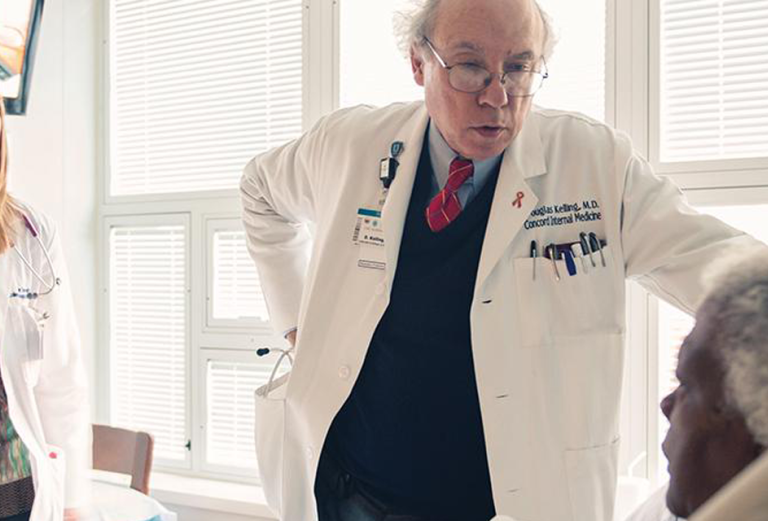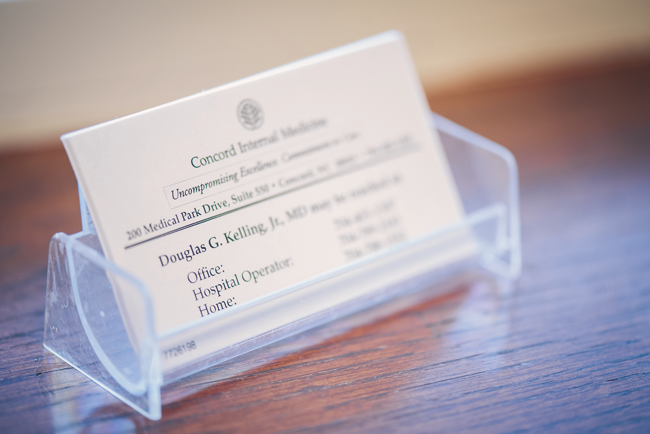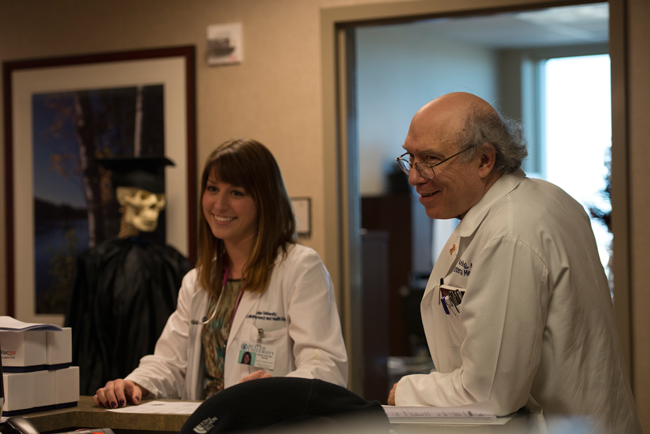The Doctor Is In (Transition)
A practitioner of primary care medicine shows pluck in a time of change
- 12 minute read
- Profile

Douglan Kelling at a patient’s bedside
On a recent winter morning, twilight was moving to dawn as Doug Kelling ’72 made his way to the bedsides of his patients at the Carolinas Medical Center–Northeast in Concord, North Carolina. On this day, as on all weekdays, Kelling arrived at the hospital around 5:30 a.m. and would remain at the medical center until 10 p.m. During those hours, he would confer with his team of health care professionals; respond to inquiries from physicians, staff, and patients; monitor the operation of his clinic; tangle with the computer system; wade through paperwork, and, of course, do what Kelling, an internist and a pulmonologist, is trained to do—diagnose, assess, and treat his patients, those in the hospital and those in the clinic. He’d also shoehorn in time for lunch and, around 7 p.m., would head home for an hour for dinner with his wife, before returning to the hospital. Weekends he works only seven hours each day.

Kelling’s work week is the tip of an iceberg of demands facing today’s primary care physicians. These physicians are the first, and often abiding, face of medical care for their patients, serving as advocates for access to the health care system and providing a range of services that includes the diagnosis and treatment of acute and chronic ailments, prevention strategies, and health education.
In this nation, the primary care physician’s patient population is made up largely of an escalating number of elderly who suffer from multiple chronic conditions. And soon that population will gain an estimated 32 million Americans, beneficiaries of the Affordable Care Act.
This deep river of need, however, is being served by a narrowing stream of practitioners, choked on one side by attrition and on the other by meager recruitment, each a function of the profession’s demands and the knowledge that compensation for time and caregiving is often inadequate.
To stay in the field, then, presents a daunting prospect. But Kelling and a like-minded cohort of his peers are not only staying, they are actively introducing innovations to their practices, reforms that they hope will meet or surpass the challenges presented by the communities they serve and by the nation’s health care system in general. These physician innovators aim to devise new systems that can remain resilient in a changing landscape of primary care while also improving the delivery of that care—and the culture of the profession.
Terry No More
Although Kelling is the first to admit that the changes he made to his practice may not represent the model for primary care—“If you’ve seen one medical practice model, you’ve seen one medical practice model”—he does think that the system his team uses serves the people of Concord well. It delivers comprehensive, coordinated care that focuses on the long-term needs of each patient and each patient’s family.

Meeting Kelling’s patients brings you face-to-face with the evolving population of North Carolina’s Piedmont region. Although the practice primarily serves patients who qualify for Medicare and Medicaid, it also serves private-pay clients. Some patients are new to the group—unlike a lot of overstretched practices, Kelling’s remains open to new patients—but many, ever so many, have been coming to see Kelling for generations.
“This is a loyal, close-knit community,” says Kelling, “but it’s not a closed community; we see about 50 new patients a month. People who’ve grown up here often have their parents and their children living here. It’s not uncommon that when the parents are satisfied with the care they receive, or the grandparents are satisfied with the care, they’ll want their children and grandchildren to receive that care.”
The community’s cohesiveness owes much to its roots as a textile town. The site of the second mill for what was then the towel-making Cannon Manufacturing Company, Concord and its residents benefited from the vision of Charles A. Cannon, son of James W., the company’s founder. Homes, schools, churches, all were built by the company for the workers and their families. Even care for the workers’ physical health was a part of Cannon’s plan for the community; the firm’s ledgers describe a site where the company’s workers received medical care. That site, known as Plant 13, has developed into the current medical center complex.
For more than a century, the residents of Concord and its environs wove tight bonds inside and outside the factories. Then a series of changes in ownership and a shift in the nation’s manufacturing climate brought it all to a halt: in 2003, the last owner declared bankruptcy. A single factory that had employed 47 percent of Concord’s population was shuttered after one month’s notice.
“People lost their insurance,” says Lynn Bailey, a registered nurse who manages the practice’s clinical and hospital arms and has lived in the area since 1983. “They had no way to pay for medical care, no way to get their medications. Grandparents were raising grandchildren and were making choices between rent and food and medications. Noncompliance snowballed and more and more people became sicker and sicker.”
Electronic Shock
To meet the community’s needs, throughout the past three decades, Kelling has systematically customized his operation. He has assembled and implemented a team-based approach to caregiving, crafted protocols that codify and unify procedures for oft-seen chronic conditions, developed a drug dispensary to ensure patients access to medications, served as a mentor to medical students and students of other health professions who intern with him, and moved medical records and metrics related to caregiving to an electronic platform.
Although the latter change is seen by many as vital to efforts to reform how medicine is delivered, care outcomes are monitored, and efficiencies are found, the practice’s shift to electronic medical records has not been without headache. The team successfully migrated all patient records, which, according to a recent poll, places the practice among the nearly 18 percent of U.S. primary care practices that have done so. And team members have become proficient in using the system, dictating directly into it using voice-recognition software. Yet, the computer system’s reliability is uneven—up and down three times in one day, for example—and that, according to Kelling, is not the worst of it.
“I would have to say that information technology is really very primitive,” says Kelling, who once programmed computers. “It slows us down. It’s not logical in terms of how fields are structured, and it’s clearly not designed by people who understand workflow. Right now, it’s cut our efficiency by 25 percent. We have good numbers on that.”
Parts of the Whole
Achieving this or any sort of procedural overhaul requires staff and coordination. When Bailey joined the practice 14 years ago, there were about 15 employees, including Kelling, a second nurse, and two physician assistants. Today, according to Bailey, the practice has seven nurses and is “fifty-five staff strong.” In addition to Bailey and Kelling, the lineup includes clinic physicians Carmella Gismondi-Egan and George Monroe; six physician assistants; three doctors of pharmacy (PharmDs); registered nurses who “run with” the doctors as they see patients to ensure all physician orders are captured and all tests arranged; a case worker; patient service representatives for checking patients in and out; certified medical assistants for bringing patients to the exam rooms, taking vital signs, and gathering appointment-related information for the doctors; and a staff member who refills medications according to relevant protocols. The clinic serves between 12,000 and 13,000 patients, and there are approximately 30 beds in the hospital unit Kelling oversees.
“The size of our patient population would be significant,” says Kelling, “if you discussed it from the standpoint of the number of doctors we have: three. But if you take a team-based approach, as we have, it’s much more manageable.”
Summing the Parts
The team-based concept calls for using health care professionals to augment the capacity of physicians. As in Kelling’s practice, these so-called extenders can be case managers, physician assistants, nurse practitioners, pharmacists, nutritionists, or any professional whose licensure allows them to deliver specialized care independently, under the guidance of a physician.
Bailey says the work of these extenders is dictated by “common sense and their compassion to take care of our patients,” as well as by a body of disease protocols that Kelling has developed over the years.
“When I joined his practice,” says Bailey, “he had developed the first protocol—it was for diabetes. Now there are fifteen different disease process protocols, these flow diagrams, that all tie back together. We use them for all disease types, some being COPD, diabetes, asthma, anemia of chronic disease, hypertension, chronic kidney disease, mental health, osteoporosis, whatever our patients present with. This means that the staff nurses, the clinical nurses, the clinical staff, and the nonclinical staff have the ability to do what they need to do to take care of the patient. They know what is expected and how to do it.”
The team’s PharmDs, for example, manage the 300 or so patients taking coumadin, performing the diagnostic fingerstick, determining drug levels in the blood, and regulating dosage—all determined by Kelling’s protocol. They also see the practice’s 1,200 patients with diabetes, teaching each how to monitor glucose levels, administer insulin at the dose needed, and use an insulin pump. The half dozen physician assistants see patients and take histories; review lab work, diagnostic tests, and X-rays; and, based on protocols, make recommendations for treatment.
Other team members coordinate care outside the clinic. Three discharge planners help arrange home health care or placement in nursing or rehabilitation facilities; a case worker assists in organizing transportation, filling out insurance forms, and stocking home pantries; and a medication coordinator sees that patients who can’t afford their prescribed drugs can obtain them from pharmaceutical firms. All patients within the Carolinas HealthCare system, the medical center’s parent group, benefit from this medication assistance program. Another service, also spurred by Kelling’s efforts, is keyed to the needs of his clinic’s patients.
Even before the town lost its principal employer, Kelling had been meeting with pharmaceutical reps, learning about new medications, and cultivating relationships that he later leveraged into support for an in-clinic pharmacy of drug samples. The tangible results of his campaign can be found in a closet at the clinic, one outfitted with movable floor-to-ceiling shelves holding small plastic bins, each neatly labeled with the name of the drug that fills it. Throughout the day, small brown paper bags containing prescription medications travel from closet to waiting patients’ hands, then out the door. The samples serve to tide patients over until a prescription, or an application for prescription assistance, comes through.

Prime Time
Observing Kelling’s practice, it’s hard not to wonder whether it can be sustained in the coming years. The day-to-day demands seem to grow exponentially. Listening to Gismondi-Egan, Monroe, and Kelling talk about what they must cover during the course of a clinic visit, the so-called metrics of a visit—a short litany includes reviewing guidelines for disease, weight management, smoking cessation, pain control, health literacy, vaccination, advance directives, preventive screenings, medication dosages, lab results, and working with patients on their health-related decisions to ensure that those decisions are informed—a submerged current of dismay is evident. These are professionals who love their jobs, who are committed to primary care medicine, yet who understand all too well its demands. The fact that they are part of a team brings them solace and hope. But each voices worry about the field’s future. Will there be new doctors to care for the coming generations of patients? Will there be primary care practitioners to take care of them? As might be expected, the team is innovating on this front, too.
For about a decade now, the practice has hosted physician assistants, nurse practitioners, and medical students for 10-week rotations, half spent on the hospital side, half in the clinic. The interns experience day-to-day internal medicine and learn at Kelling’s side. “He teaches without teaching,” says Bailey, “with everything you do and everywhere you go, you learn from him.”
The practice has established affiliations with some schools in North Carolina, but has also drawn from schools in New York, Alabama, Georgia, and Mississippi. It has even brought in students from overseas.
That Human Touch
Kelling thinks that one way to encourage medical students to enter primary care is to train them to be team leaders, to prepare them to supervise 15 to 20 health care professionals, to teach them what they can do, and, just as important, what they can’t do within the changing landscape of the field.
“We need to train primary care physicians that it’s their job to coordinate their patients’ care,” says Kelling. “Health care is now so complicated and complex that I think patients feel strongly that they’ve got to have an advocate. I think if primary care is ever going to have an identity again, it’s got to recognize that one of its strongest suits is being an advocate for the patient in terms of different treatments, different medications, different opinions, and different options.”
A century or more ago, primary care medicine was medicine. Physicians were entrepreneurs who had some training in the medical arts, and they served their clientele privately and personally. They visited homes to diagnose and treat, sometimes staying for hours or days to deliver babies, care for sick children, or see to the needs of the frail and the elderly. It was care undertaken in partnership with the patient and his or her family, and conducted within a community.
These fundamentals of the art remain unchanged even amid the challenges that confront today’s primary care physician. “We want to help people,” says Kelling, “we want to make them feel better in any way we can. Ours is a humanistic approach.”
Ann Marie Menting is editor of Harvard Medicine.